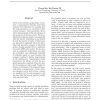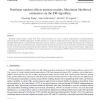1086 search results - page 9 / 218 » Subspace Analysis Using Random Mixture Models |
ICPR
2002
IEEE
14 years 8 months ago
2002
IEEE
This paper proposes the fractional component analysis (FCA), whose goal is to decompose the observed signal into component signals and recover their fractions. The uniqueness of o...
JMLR
2010
13 years 2 months ago
2010
Given several related learning tasks, we propose a nonparametric Bayesian model that captures task relatedness by assuming that the task parameters (i.e., predictors) share a late...
BMCBI
2007
13 years 7 months ago
2007
Background: Serial analysis of gene expression (SAGE) is used to obtain quantitative snapshots of the transcriptome. These profiles are count-based and are assumed to follow a Bin...
PCI
2005
Springer
14 years 29 days ago
2005
Springer
Abstract. It has been recently demonstrated that the classical EM algorithm for learning Gaussian mixture models can be successfully implemented in a decentralized manner by resort...
CSDA
2007
13 years 7 months ago
2007
Nonlinear random effects models with finite mixture structures are used to identify polymorphism in pharmacokinetic/ pharmacodynamic (PK/PD) phenotypes. An EM algorithm for maxim...


